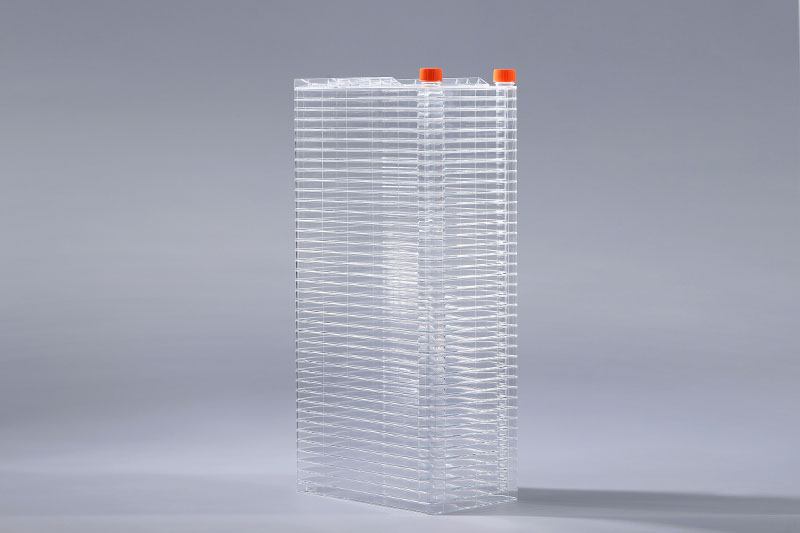Бактериальное заражение является частым источником загрязнения при использовании Ключом к бактериальному заражению является профилактика. Добавление антибиотиков в культуральную среду клеточной фабрики может предотвратить и устранить небольшое количество бактериального загрязнения. Если выполняется несколько клеточных культур, аппарат должен быть строго отделен, чтобы предотвратить кросс-клеточную инфекцию. для культивирования клеток, в том числе Escherichia coli, Staphylococcus albus, Pseudomonas и т. д. Что делать, если клетки заражены бактериями? загрязнение: бактериальное загрязнение отличается от других источников загрязнения. Когда клетки на клеточной фабрике загрязнены, это легко обнаружить. В большинстве случаев культуральный раствор за короткое время желтеет, что свидетельствует о выработке большого количества кислых веществ, и возникает явное помутнение; Питательную среду сначала не перемешивали, но после небольшого встряхивания всплыло много мутных веществ. При наблюдении под инвертированным микроскопом видно, что в культуральной среде плавает большое количество сферических частиц, а иногда на поверхности клеток и вокруг нее существует большое количество бактерий, и клетки перестают расти и обнаруживают отравление. При необходимости можно взять небольшое количество мазка питательной среды для окрашивания для определения вида бактерий; если некоторые изменения питательной среды не очевидны и есть подозрение на загрязнение, небольшое количество питательной среды также можно добавить в бульонную среду и культивировать при 37 градусах для обнаружения. Терапия может проводиться с использованием в 5-10 раз больше обычного количества антибиотиков, а обычная культуральная среда может быть заменена через 24-48 часов после приема лекарства. Этот метод эффективен при раннем загрязнении. Если он обнаружен поздно и загрязнение серьезное, рекомендуется отказаться от клеток.
Judgment of pollution: Bacterial pollution is different from other pollution sources. Once the cells in the cell factory are polluted, it is easy to detect. In most cases, the culture solution turns yellow in a short time, indicating that a large amount of acidic substances are produced, and obvious turbidity occurs; The culture medium was not mixed at first, but after a little shaking, many turbid substances floated. Observed under an inverted microscope, it can be seen that there are a large number of spherical particles floating in the culture medium, and sometimes a large number of bacteria exist on and around the cell surface, and the cells stop growing and show poisoning. When necessary, a small amount of culture medium smear can be taken for staining to determine the type of bacteria; if some culture medium changes are not obvious and there is suspected contamination, a small amount of culture medium can also be added to the broth medium and cultured at 37 degrees for detection.
Treatment of pollution: After bacterial pollution is found, shock therapy can be performed with 5-10 times the usual amount of antibiotics, and the conventional culture medium can be changed after 24-48 hours of medication. This method is effective in early pollution. If it is found late and the contamination is serious, it is recommended to discard the cells.
The key to bacterial contamination is prevention. Adding antibiotics to the culture medium of the cell factory can prevent and eliminate a small amount of bacterial contamination. If multiple cell cultures are performed, the apparatus should be strictly separated to prevent cross-cell infection.
The FAI climbed 5.9 percent year-on-year in the first 11 months of 2018, quickening from the 5.7-percent growth in Jan-Oct, the National Bureau of Statistics (NBS) said Friday in an online statement.
The key indicator of investment, dubbed a major growth driver, hit the bottom in August and has since started to rebound steadily.
In the face of emerging economic challenges home and abroad, China has stepped up efforts to stabilize investment, in particular rolling out measures to motivate private investors and channel funds into infrastructure.
Friday's data showed private investment, accounting for more than 60 percent of the total FAI, expanded by a brisk 8.7 percent.
NBS spokesperson Mao Shengyong said funds into weak economic links registered rapid increases as investment in environmental protection and agriculture jumped 42 percent and 12.5 percent respectively, much faster than the average.
In breakdown, investment in high-tech and equipment manufacturing remained vigorous with 16.1-percent and 11.6-percent increases respectively in the first 11 months. Infrastructure investment gained 3.7 percent, staying flat. Investment in property development rose 9.7 percent, also unchanged.
 English
English



















































